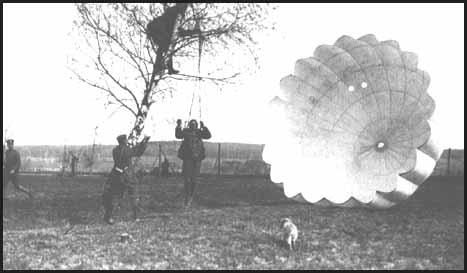Parachutes
The parachute was invented by André Jacques Garnerin (1769-1823). It consisted of a white canvas canopy 23 feet in diameter. The parachute had 36 ribs and lines, was semi-rigid, making it look like a very large umbrella.
Garnerin made his first successful parachute jump above Paris on 22nd October, 1797. After ascended to an altitude of 3,200 feet (975 m) in an hydrogen balloon he jumped from the basket. As Garnerin failed to include an air vent at the top of his parachute, he oscillated wildly in his descent. However, he landed unhurt half a mile from the balloon's takeoff site.
Garnerin therefore became the first man to design a parachute that was capable of slowing a man's fall from a high altitude. Garnerin made exhibition jumps all over Europe including one of 8,000 feet (2,438 m) over London in September 1802.
In the 1880s parachutes were used by circus showman jumping from balloons. The first parachute jump from an aeroplane took place in St. Louis, Missouri in March, 1912.
On the outbreak of the First World War, parachutes were issued to crews of airships and balloons. It was claimed at the time that parachutes were too bulky to be used by pilots of aircraft. R. E. Calthrop, a retired British engineer, had in fact developed the Guardian Angel, a parachute for aircraft pilots, before the war. He informed the Royal Flying Corps (RFC) of his invention and successful tests were carried out by Mervyn O'Gorman, Superintendent of the Royal Aircraft Factory at Farnborough.
Despite encouraging test results, Sir David Henderson, Commander of the RFC, was unwilling to give permission for them to be issued to his pilots. Pressure was also applied on Calthrop not to publicize his invention. With growing numbers of pilots dying as a result of their aircraft being hit by enemy fire, Calthorp rebelled and in 1917 advertised his Guardian Angel parachute in several aeronautical journals. Calthorp revealled details of the tests that had been carried out by the Royal Flying Corps and pointed out that British pilots were willing to buy their own parachutes but were being denied the right to use them.

The Air Board responded to Calthorp's adverts by setting up a committee to look into the possibility of allowing RFC pilots to use parachutes. Although some members of the committee favoured their use, the Air Board decided against the measure. Officially the reason given was that the Guardian Angel was not 100% safe, it was too bulky to be stored by the pilot and its weight would affect the performance of the aeroplane. Unofficially the reason was given in a report that was not published at the time: "It is the opinion of the board that the presence of such an apparatus might impair the fighting spirit of pilots and cause them to abandon machines which might otherwise be capable of returning to base for repair." However, the Royal Flying Corps did decide to use them to drop Allied spies behind enemy lines.
Pilots such as Major Mick Mannock became increasingly angry about the decision to deny British pilots the right to use parachutes. He pointed out that by 1917 they were being used by pilots in the German Airforce, French Army Air Service and the United States Air Service Instead of carrying parachutes, RFC pilots carried revolvers instead. As Mannock explained, unable to carry a parachute, he had a revolver "to finish myself as soon as I see the first signs of flames."
Primary Sources
(1) Major Archibald James, argued that even if the Royal Flying Corps had agreed to the use of parachutes, there would have been serious practical problems.
The development of parachutes was in its infancy and the only available parachutes were so cumbersome and big that there simply wasn't room for them in the cockpit. The harness would have affected the efficiency and mobility of the personnel in the aircraft - they'd have been jammed into their seats. It simply wasn't practical to have them.
(2) Arthur Gould-Lee was a British fighter pilot during the First World War.
Why, demanded press and public, if balloonists could escape death by parachute, could not the crews of heavier-than-air aircraft?The primary answer of RFC Headquarters was that no parachute suitable for aeroplanes existed. Even if this been true, any kind of parachute could have been developed rapidly under the spur of war, just as the primitive aircraft of 1914 had swiftly advanced in performance under this spur. But it was untrue. Not only did the authorities shut their minds to the achievements of Stevens, Law, Berry and Newall, but they refused to accord any merit to a British parachute, the Guardian Angel, which R. E. Calthorp, a retired engineer, had produced and convincingly tested just before the war. But the RFC chiefs declined to consider it. They said it was not safe - as if diving to one's death in a burning aeroplane was safer!
